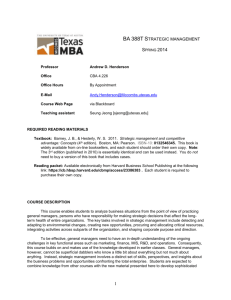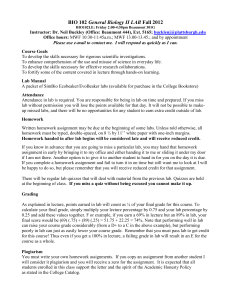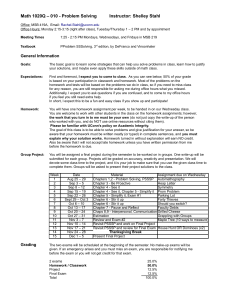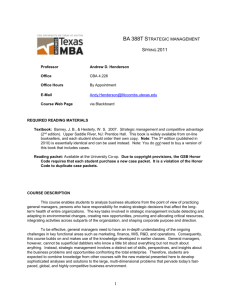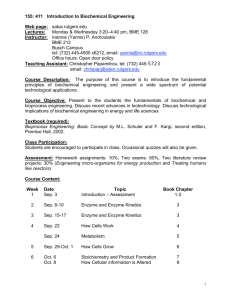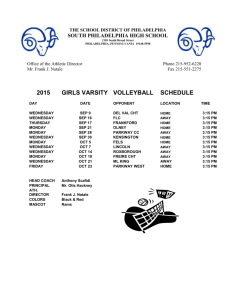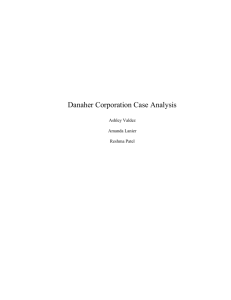MAN 374 - General Management and Strategy
advertisement
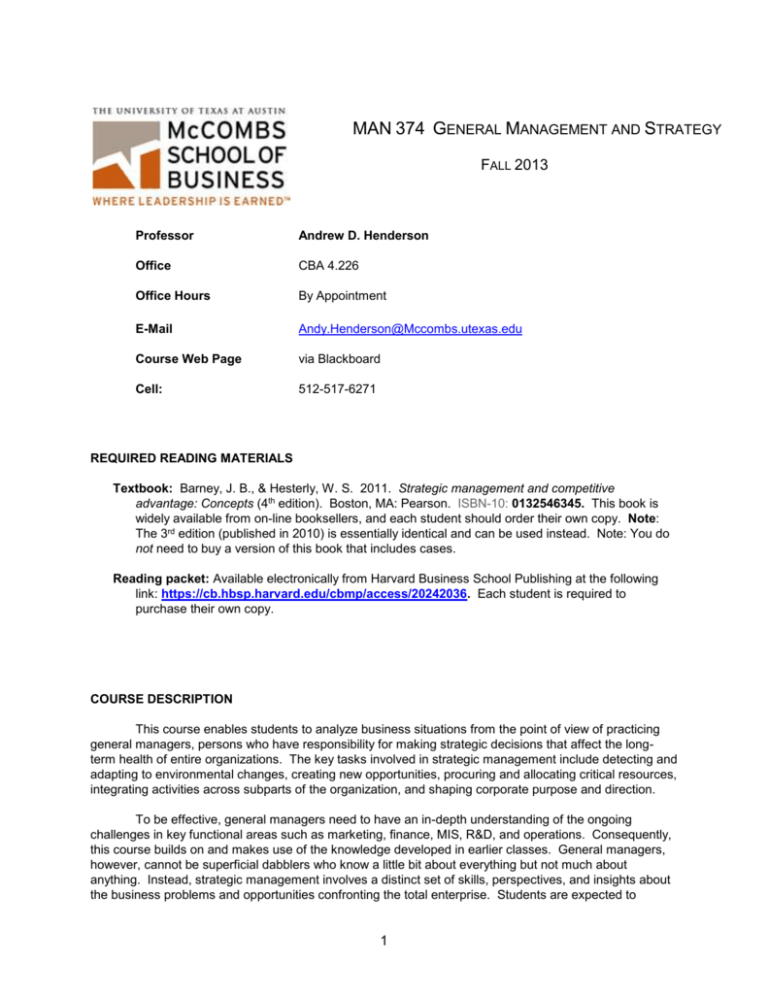
MAN 374 GENERAL MANAGEMENT AND STRATEGY FALL 2013 Professor Andrew D. Henderson Office CBA 4.226 Office Hours By Appointment E-Mail Andy.Henderson@Mccombs.utexas.edu Course Web Page via Blackboard Cell: 512-517-6271 REQUIRED READING MATERIALS Textbook: Barney, J. B., & Hesterly, W. S. 2011. Strategic management and competitive advantage: Concepts (4th edition). Boston, MA: Pearson. ISBN-10: 0132546345. This book is widely available from on-line booksellers, and each student should order their own copy. Note: The 3rd edition (published in 2010) is essentially identical and can be used instead. Note: You do not need to buy a version of this book that includes cases. Reading packet: Available electronically from Harvard Business School Publishing at the following link: https://cb.hbsp.harvard.edu/cbmp/access/20242036. Each student is required to purchase their own copy. COURSE DESCRIPTION This course enables students to analyze business situations from the point of view of practicing general managers, persons who have responsibility for making strategic decisions that affect the longterm health of entire organizations. The key tasks involved in strategic management include detecting and adapting to environmental changes, creating new opportunities, procuring and allocating critical resources, integrating activities across subparts of the organization, and shaping corporate purpose and direction. To be effective, general managers need to have an in-depth understanding of the ongoing challenges in key functional areas such as marketing, finance, MIS, R&D, and operations. Consequently, this course builds on and makes use of the knowledge developed in earlier classes. General managers, however, cannot be superficial dabblers who know a little bit about everything but not much about anything. Instead, strategic management involves a distinct set of skills, perspectives, and insights about the business problems and opportunities confronting the total enterprise. Students are expected to 1 combine knowledge from other courses with the new material presented here to develop sophisticated analyses and solutions to the large, multi-dimensional problems that pervade today’s fast-paced, global, and highly competitive business environment. While not all students will become general managers, for several reasons this course should benefit virtually all who take it. First, ongoing trends in the corporate world towards flatter, less hierarchical organizations have resulted in strategic decisions being made at ever lower hierarchical levels, often by relatively inexperienced people. As a result, leadership responsibilities may be thrust upon you very early in your career. Second, a number of factors, including technological change and the continuing shift to global markets, have forced established firms to become increasingly innovative and entrepreneurial, and such initiatives are often led by people at lower organizational ranks. Third, functional specialists, including professionals in finance and marketing, are the people on whom general managers rely to implement a firm’s existing strategy and collect the data needed to update and revise it. Finally, while specialists are often under intense pressure to fix problems in their own areas, the seemingly isolated actions taken to fix such problems can have profound implications for the firm as a whole. As a result, all professionals need to have a solid understanding of strategy. Verbal communication is both vital to and inseparable from strategic management. This has two critical implications for this class. First, there will be relatively few lectures. We will instead emphasize case discussion because strategy is best learned by immersion in actual business situations where one can fully appreciate the inherent conflicts, pressures, uncertainties, and risks that general management entails. Second, a case-based approach necessitates learning by doing, so your active contribution to class discussions is integral to your knowledge development. PERFORMANCE MEASURES AND FEEDBACK Components and Weighting Your grade will be based on three components, weighted as follows: Class contribution (individual) Half (12.5%) assessed 8/29 – 10/10 Half (12.5%) assessed 10/15 – 11/14 Case write ups (3-5 person teams) Mid-term case analysis (individual) Final project (5-person teams) 25% 10% 25% 40% 100% 2 Key Due Dates Sep 10 Final project: Group member list Sep 17 Final project: Focal industry and firm choices Sep 24 Final project: Proposal Sep 26 Case write up: RBV vs. Porter Oct 15 Mid-term case analysis Oct. 29 Final project: Draft report Oct 31 Case write up: Danaher Nov 7 Case write up: Vivendi Nov 5 Final project: Critique Nov 19 – Dec 3 Final presentations. Bring hard copies to class to distribute. Dec 12 Final project: Final report Do 1 of these 2 case write ups Class Contribution Why is class contribution a major portion of the grade in every strategy course at top business schools? It’s simple. One, general managers are extremely busy. Two, getting things done requires both learning from and convincing others. Three, as a result, general managers spend most of their time engaged in verbal conversation. Let me address those of you who find speaking in front of your peers (or me) to be stressful. I’m a bit of an introvert myself, so I empathize with you. The good news for folks like me (and possibly you) is that public speaking is a skill like any other – writing, doing NPV calculations, schmoozing people in bars – because it improves with practice. This course is organized to help you practice speaking with others about matters of strategic importance. At the start of a typical session, several students will be asked to open the class by answering a specific question. Case preparation, which includes careful attention to the assignment questions and associated readings, should be sufficient to handle such lead-off responsibilities. After a few minutes of initial analysis, we will then open the discussion to the rest of the class. During our discussions, I always look for and appreciate volunteers, but please bear in mind that anyone can be cold called at any time. In your comments, you should have a “high contribution-to-words ratio”. Monopolizing air time is not valued. Many of the questions we address in class will involve the assigned cases. However, other questions will involve the assigned readings (e.g., book chapters, HBR articles.) Regarding those readings, you should always be prepared to answer these questions: What was the author’s purpose? What were the reading’s strengths, weaknesses, and key assumptions? What were the author’s major points? And how do we apply those points to today’s case? Finally, should you expect that high quality case discussion will come naturally and easily? No, especially at the start of the course. However, the key features of case discussion (incomplete information, uncertain outcomes, pressurized environments, competing solutions, the need to persuade others with evidence) are the same ones that you will face constantly in your career beyond McCombs. 3 In assessing your class contributions, I ask myself the following questions: a. Is this person an excellent listener? b. Are the points made relevant to the discussion and linked to the comments of others? c. Does this person demonstrate an understanding of the case and associated reading materials? d. Are comments and recommendations evidence-based ones backed by reliable data and/or course concepts? e. Does the participant distinguish among different kinds of data – facts, opinions, personal beliefs, theoretical concepts, etc.? f. Is there a willingness to test new ideas, or are all comments safe? Example of a safe comment: seconding or repeating earlier comments without elaboration or clarification. g. Does this person raise interesting questions that appropriately expand the scope of our conversation or help us cut to the heart of the matter? h. Can this person draw linkages – comparisons or contrasts – between today’s case and others that we have covered? Note: Like most important things in life, assigning class discussion scores involves an element of subjective judgment. I can promise you, though, that if several experienced professors were to sit in on one of our classes, their scoring of students’ contributions would be very highly correlated because those professors would be looking for the same indicators of deep and substantive understanding. Case Write Ups You will do two case write ups. Each will be 2-3 double-spaced pages in length, and each will be done in a 2-5 person team. You are responsible for forming your team. Team membership may be – but need not be – the same as that for your final project. In the first case analysis, which is due at the start of class on Sept. 26, 2013, you are to compare and contrast the Resource-Based View (RBV) and the Porter five forces model, including discussion of their respective units of analysis, assumptions, conclusions about sustained competitive advantage, and social welfare implications. In the second case analysis, you’ll address the focus questions in this syllabus associated with either Danaher (due Oct. 31, 2013) or Vivendi (due Nov. 7, 2013). Mid-Term Case Analysis The mid-term involves a written case analysis that you will do individually. A detailed assignment and the case itself will be distributed about 10 days before it is due. This assignment is open book, open note, and take home. You’ll be asked to answer 3-4 high-level questions of the type we consider in our class discussions. Your mid-term is due at the start of class on Tuesday, Oct. 15, 2013. The mid-term is to be solely your work. Let me state explicitly what this means. In completing the assignment, you may use the information in the case, the textbook, the readings, your head, and nothing 4 else. You are not permitted to gather any extra information regarding the case or the firm via the Internet or other means. If this is at all unclear, please see me. All case reports will be run through SafeAssign, a plagiarism detection program. This is to ensure that no one receives an unfair advantage, not because I believe that anyone is going to cheat. If you are unsure about what constitutes plagiarism, you should talk with me. Final Project The final project is a semester-long research endeavor that fulfills the University’s Independent Inquiry flag. Details are provided in a separate, accompanying document. The final project, which you will do as a member of a 5-person team, accounts for 40% of your course grade and includes the following elements: Research proposal, draft report, critique of another group’s draft, oral presentation, and final written report. Real-Time Events You should make a habit of reading business periodicals such as Business Week, the Financial Times, and The Economist. Keeping abreast of current business developments will facilitate your participation in class discussions. In addition, if you are interested in delving further into the topics that we discuss, I strongly recommend the following. Ariely, D. 2009 Predictably irrational: The hidden forces that shape our decisions New York: HarperCollins Beinhocker, E. D. 2007 The Origin of Wealth: Evolution, complexity and the radical remaking of economics Boston, Massachusetts: Harvard Business School Press Christensen, Clayton M. 2012 How will you measure your life? New York: HarperCollins Ghemawat, Pankaj Redefining Global Strategy Harvard Business School Press HBR’s 10 Must Reads, 2011 On Leadership Boston, Massachusetts: Harvard Business Review Press 5 Hoffman, Bryce G. 2012 American Icon: Allan Mulally and the fight to save Ford Motor Company New York: Crown Business Kidder, T. 1981 The soul of a new machine New York: Avon Lewis, M. 2003 Moneyball New York: Norton Miller, D. and Le Breton-Miller, I. 2005 Managing for the long run Boston, Massachusetts: Harvard Business School Press Pfeffer, J. and Sutton, R. 2006 Hard facts, dangerous half truths & total nonsense Boston, Massachusetts: Harvard Business School Press Schroeder, A. 2008 The snowball New York: Bantam-Dell 6 Other Points Please note the following: a. You must always have your name tag in front of you. This is as true on the last day of the course as the first. If you forget your name tag, make one. b. By the start of our second session (Thursday, Sept. 3), please find a seat that you like. This will be your seat for the remainder of the course. My apologies for this small bit of authoritarianism. c. I expect you to attend every class. Attendance means being on time, in your seat, ready to start, with your name tag displayed. This is a professional program, and being a professional means being accountable for performing at a high level every day. d. If you miss class, you are responsible for (i) informing me beforehand, and (ii) obtaining from your classmates any notes, handouts, additional reading materials, or assignment changes. e. In determining final grades, class contribution is given particular emphasis in settling borderline cases. f. You are strongly encouraged to form study groups and brain-storm about cases and reading assignments. g. Learning by doing is a critical feature of this course, and you deprive yourself and others of that opportunity if you discuss cases with students who have taken MAN 374 in the past or in another section during the current semester. Therefore, it is an honor code violation to send or receive any communications about what happened in another section prior to our discussion of a particular case. No talking (verbal, electronic or otherwise) or sharing notes across sections until after a focal case is finished in all sections. h. Per Management Department policy, laptop computers, tablets, and phones are not allowed. They must be turned off and closed when class begins, as must all other electronic devices. Accommodations will be made for students with disabilities. (See below.) i. The University of Texas at Austin provides upon request appropriate academic accommodations for qualified students with disabilities. For more information, contact the Office of the Dean of Students at 471-6259, 471-6441 TTY, http://www.utexas.edu/diversity/ddce/ssd/ . j. Each student is responsible for any assignment changes that arise throughout the semester. k. All students must have access to Blackboard and have their e-mail properly registered there. 7 Course Topic Overview Class 1 2 3 4 5 6 7 8 9 10 11 12 13 14 15 16 17 18 19 20 21 22 23 24 25 26 27 28 Date 8/29 9/3 9/5 9/10 9/12 9/17 9/19 9/24 9/26 10/1 10/3 10/8 10/10 10/15 10/17 10/22 10/24 10/29 10/31 11/5 11/7 11/12 11/14 11/19 11/21 11/26 12/3 12/5 Module Intro Business-level strategy Strategy implementation Corporate-level strategy Semester Project Presentations Case Cola wars cont. Edward Jones Tesla cont. eHarmony cont. Gillette cont. College sports No class Southwest cont. CTP Paul Levy Stone Finch Danaher cont. Vivendi cont. Grolsch / Bud. Groups 1 & 2 Groups 3 & 4 Groups 5 & 6 Groups 7 & 8 Topics/Tools Concept of strategy Industry analysis cont. H-F strategy diamond Innovation cont. Resource-Based View cont. Semester project feedback C3E / integration Competitive dynamics Strategic purpose Strategic types / exec levers Low cost strategy impl. Differentiation strategy impl. Logical incrementalism Implementing renewal Acquisitions cont. Diversification cont. Globalization Reflections 8 COURSE TOPICS AND ASSIGNMENTS MODULE 1: BUSINESS-LEVEL STRATEGY Session 1 Aug 29 Topics: Course introduction; the concept of strategy; the roles of the general manager Reading: Mintzberg, H. “The manager’s job: Folklore and fact”. Harvard Business Review, [90210] Reading: Barney & Hesterly, Chapter 1, “What is strategy and the strategic management process?” Reading: "Why We Use the Case Method," Appendix, Course Syllabus Focus question: (1) Why did Mintzberg write this article, and why has it been so influential? Session 2 Sep 3 Topics: Industry analysis – An introduction to the effects of industry structure on segmentation, profit potential, and competitive behavior Case: Cola Wars Continue: Coke and Pepsi in 2010 [9-711-462] Reading: Barney & Hesterly, Chapter 2, “Evaluating a Firm’s External Environment”. Focus questions: (1) Why is the soft drink industry so profitable? (2) How has the competition between Coke and Pepsi affected the industry’s profits? (3) Why is the profitability so different between the concentrate business and the bottling business? (4) Can Coke and Pepsi sustain their profits in the wake of flattening demand and the growing popularity of non-carbonated soft drinks? 9 Session 3 Sep 5 Topic: Industry analysis (cont.) Case: Cola Wars Continue (cont.) Reading: Barney & Hesterly, Chapter 6, “Vertical Integration” Reading: http://www.businessweek.com/magazine/indra-nooyi-rediscovers-the-joy-ofpepsi-02022012.html Today, we’ll continue our discussion of industry structure and competition. Session 4 Sep 10 Topic: A consideration of internal and external strategic alignment and the use of the Hambrick-Fredrickson strategy diamond to assess such alignment Case: Edward Jones in 2006: Confronting success. [9-707-497] Reading: Hambrick, D. C. and Fredrickson, J. “Are You Sure You Have a Strategy?” Academy of Management Executive, November, 2001. Available at: http://turbo.kean.edu/~jmcgill/havestrategy.pdf Focus questions: (1) Using Hambrick and Fredrickson’s Strategy Diamond framework, what is Edward Jones’ strategy as of 2006? Which elements of the strategy represent recent changes? (2) Pay particular attention to the “Economic Logic” of the strategy. Why does the company have such a high return on equity (ROE)? Can you think of other instances in which a relatively low-share player in an industry is significantly more profitable than some (or all) of the higher-share players? (3) What recommendations would you make to Mr. Weddle? 10 Session 5 Sep 12 Topic: Innovation and competitive dynamics Case: Why everyone loves Tesla (and supporting material). This is available on-line from Bloomberg Business Week at the links below. cont. http://www.businessweek.com/articles/2013-07-18/the-tesla-electric-cars-creators-chasetheir-iphone-moment . (As part of this, also watch the embedded video: “Inside Tesla: A massive factory pumping out Model S”.) cont. http://www.businessweek.com/articles/2013-07-12/beyond-tesla-rival-electric-car-makersshred-sticker-prices cont. http://www.businessweek.com/articles/2013-05-22/tesla-pays-off-its-465-million-loser-loan cont. http://www.businessweek.com/articles/2013-05-17/why-grumpy-car-dealers-are-helpingtesla Reading: Bower, J. L., & Christensen, C. M. Disruptive technologies: Catching the wave. Harvard Business Review, [95103] Focus questions: (1) Why is Tesla’s entry into the automobile industry noteworthy? (2) Has Tesla’s entry been a success or failure? How do you judge that? (3) What roles does innovation play in Tesla’s performance to date? (4) How will Tesla’s entry affect the broader automobile industry? (5) What threats does Tesla face in the future, and what should it do to mitigate those threats? 11 Session 6 Sep 17 Topic: Innovation and competitive dynamics (cont.) Case: Tesla (cont.) Reading: Fleming, L. “Breakthroughs and the ‘Long Tail’ of Innovation”, Sloan Management Review [SMR 265] Reading: Tushman, M. L., & O’Reilly, C. A. O. “The tyranny of success: Managing for today and tomorrow”. [2427BC] In this session, we will continue our discussion of Tesla and address some broader effects of innovation and technological change. Focus questions: (1) How do established firms typically respond when confronted with new technologies? (2) Thinking beyond the Tesla case, what are three firms that have dealt successfully with technological change? What are three firms that have not dealt successfully with such change? What are the reasons for their differing outcomes? (3) What advice would you give Elon Musk? Session 7 Sep 19 Topics: Firm resources and capabilities; consideration of firm-level factors leading to sustained competitive advantage Case: eHarmony. [9-709-424] Reading: Prahalad, C. K., and Hamel, G. “The Core Competence of the Corporation”, Harvard Business Review. [90311] Focus questions: (1) How structurally attractive is the on-line personals market? (2) Does eHarmony have a competitive advantage? If so, where does it come from? (3) How serious is the competitive threat to eHarmony? 12 Session 8 Sep 24 Topics: Firm resources and capabilities (cont.) Case: eHarmony (cont.) Reading: Barney & Hesterly, Chapter 3, “Evaluating a Firm’s Internal Capabilities” Focus questions: (1) Which of the four options should Waldorf pursue? (2) What are the major differences between the Resource-Based View and Porter’s five forces model? What are the strengths and weaknesses of each model? Session 9 Sep 26 Topic: IIF project review and feedback. Session 10 Oct 1 Topics: Application of the C3E framework to integrate ideas covered to date. The Gillette case is an older one, but its lessons are timeless, and it provides a perfect platform to learn how to apply the C3E framework to a very broad variety of companies. Case: Gillette’s Launch of Sensor. [9-792-028] Reading: Reread Barney & Hesterly, Chapter 2, “Evaluating a Firm’s External Environment”, with particular emphasis on ideas about competitive dynamics. Focus questions: (1) Should Sensor be launched as a cartridge or disposable razor? How do industry trends affect this decision? (2) How much advertising should be used to launch Sensor? $10 million? $20 million? (3) What should be the schedule for launching Sensor? How should schedules vary around the world (Europe, U.S., Asia, etc.)? 13 Session 11 Oct 3 Topic: Integration via C3E (cont.) Case: Gillette’s Launch of Sensor. (cont.) Reading: http://online.wsj.com/article/SB10001424052702303624004577338103789934144.html Today, we will continue our discussion of Gillette’s launch of the Sensor product. Session 12 Oct 8 Topic: Strategy is about dealing with big, complex topics that people feel very strongly about, so let’s think about … college football! College basketball!! And some other college sports!!! Here are two contrasting points of view about the role of college sports. Case: http://www.theatlantic.com/magazine/archive/2011/10/the-shame-of-collegesports/308643/?single_page=true Case: http://sportsillustrated.cnn.com/2011/writers/seth_davis/09/21/Branch.rebuttal/index.html Focus questions: (1) What role should college athletics play at UT? Should top universities such as UT follow the Ivy League model and not offer athletic scholarships? (2) Should we pay college athletes? If so, how? (3) What alternatives might work better than the existing system? Session 13 Oct 10 No class … (something to do with a large college sporting event in Dallas). 14 MODULE 2: STRATEGY IMPLEMENTATION Session 14 Oct 15 Topic: Strategy implementation through executive levers and strategic types. Case: Southwest Airlines – 2002: An Industry Under Siege [9-803-133] (skim for background) Case: Southwest Airlines: In a different world [9-910-419] Focus questions: (1) During the 1990s, none of the five largest air carriers in the U.S. earned its cost of capital. Yet despite the industry’s challenges, airlines like Southwest and Jet Blue earn enviable returns. What explains this? (2) How vulnerable is Southwest to imitation? (3) In the next 5-10 years, what kinds of things – those over which Southwest’s leadership has some control – could go wrong? What should be done to make sure these things don’t happen? (4) Would you recommend that Southwest acquire the gates and slots available at LaGuardia? Why? Session 15 Oct 17 Topic: Cost advantage strategy – how to implement it. Reading: Pfeffer, J. Producing sustainable competitive advantage through the effective management of people. Academy of Management Executive, 19(4): 95-106. Available at: http://kimboal.ba.ttu.edu/Selected%20writings/Pfeffer%202005%20AME%20Prod ucing%20Sustainable%20Competitive%20Advantage%20through%20people.pdf Reading: Barney & Hesterly, Chapter 4, “Cost leadership” Today, we’ll continue our discussion of Southwest and strategy implementation. 15 Session 16 Oct 22 Objective: Differentiation advantage – how to implement it. Case: Cambridge Technology Partners [9-496-005] Reading: Locke, E. A. “Linking Goals to Monetary Incentives”, Academy of Management Executive, 18(4): 130-133. Available at: http://umdrive.memphis.edu/tdryan/public/SLC7321/Reward%20system%20and% 20Goals/Locke%20Linking%20Goals%20to%20Monetary%20Rewards.pdf Reading: Barney & Hesterly, Chapter 5, “Product differentiation” Focus questions: (1) How fast should CTP try to grow? What are the key constraints on its growth? (2) How should CTP compensate its employees? (3) What strategic type should CTP implement in the future? Session 17 Oct 24 Topics: Strategy implementation – taking charge in a new job; using logical incrementalism to overcome organizational and individual resistance to change. Case: Paul Levy: Taking charge of the Beth Israel Deaconess Medical Center (A) [9303-008] Note: This includes both a regular pdf file and a multimedia case. You are responsible for reviewing multimedia materials listed on the case’s calendar through March 5, 2002. Reading: Gabarro, J. J. “When a new manager takes charge”, Harvard Business Review. [Reprint 95204] Reading: Barthelemy, J. The experimental roots of revolutionary vision. Sloan Management Review. [SMR229] Focus questions: (1) How would you describe the situation Levy inherited at the BIDMC? What challenges did he face? Why did previous turnaround efforts fail? (2) How did Levy get started in his new job? What were his objectives, and what did he accomplish? (3) What was distinctive about the way that Levy went about formulating, announcing and implementing the recovery plan? (4) How does Levy overcome resistance? 16 Session 18 Oct 29 Topics: Implementing strategic renewal. Case: Stone Finch, Inc.: Young Division, Old Division [3214] Reading: O’Reilly, C., and Tushman, M. “The Ambidextrous Organization”, Harvard Business Review. [6581] Focus questions: (1) What is your assessment of Jim Billings’ performance as president of Stone Finch? What do you think of his leadership style? (2) What is your assessment of the entrepreneurial subsidiary concept? (3) What should Jim Billings do? 17 MODULE 3: CORPORATE-LEVEL STRATEGY Session 19 Oct 31 Topics: Vehicles of corporate strategy: Mergers and acquisitions Case: Danaher Corporation. [9-708-445] Reading: Barney & Hesterly, Chapter 10, “Mergers and Acquisitions” Focus questions: (1) What role do acquisitions play at Danaher? (2) What allows Danaher to be successful in its strategy? (3) What assumptions are built into Danaher’s strategy that are at risk of not holding in the future? (4) What are the limitations to Danaher’s strategy? Session 20 Nov 5 Topics: Vehicles of corporate strategy: Mergers and acquisitions (cont.) Case: Danaher Corp. (cont.) Reading: Christensen, C. M., Alton, A., Rising, C., & Waldeck, A. The new M&A playbook. Harvard Business Review [R1103B] Reading: Kale, P., Singh, H., & Raman, A. P. Don’t integrate your acquisitions, partner with them. Harvard Business Review. [R0912M] Today, we will continue our discussion of Danaher and acquisitions as a means of diversifying. 18 Session 21 Nov 7 Topics: Drivers and consequences of corporate diversification. Case: Vivendi: Revitalizing a French Conglomerate [9-799-019] Reading: Barney & Hesterly, Chapter 7, “Corporate diversification” Focus questions: (1) What is Vivendi’s corporate vision? How does the firm intend to create value? (2) What benefits does Vivendi attain from operating in multiple businesses? (3) How does the business environment in France affect Messier’s plans and his ability to carry them out? (4) What are the major risks associated with Vivendi’s strategy? Session 22 Nov 12 Topics: Drivers and consequences of corporate diversification (cont). Case: Vivendi (cont.) Reading: Goold, M. and Campbell, A. “Desperately Seeking Synergy”, Harvard Business Review. [98504] Today, we’ll continue our discussion of the opportunities and challenges associated with diversification. 19 Session 23 Nov 14 Topics: Strategy and globalization. Note: We’ll be drawing contrasts between Grolsch and Bud, so it’s very important to read both cases. Case: Grolsch: Growing globally [PG0-001] Case: http://www.businessweek.com/articles/2012-10-25/the-plot-to-destroy-americasbeer Reading: Barney & Hesterly, Chapter 11, “International strategy” Reading: Review: Barney & Hesterly, Chapter 6, “Vertical Integration” Focus questions: (1) Why did Grolsch globalize, and how well has it performed internationally? (2) Did Budweiser’s merger with InBev add value? What lessons should Grolsch take from Bud’s experience as it implements its merger with SABMiller? (3) How is the global beer industry likely to evolve in the future? 20 Sessions 24-27: Project Presentations Tuesday, Nov 19 Groups 1 and 2 Thursday, Nov 21 Groups 3 and 4 Tuesday, Nov 26 Groups 5 and 6 Tuesday, Dec 3 Groups 7 and 8 Session 28 Dec 5 Topic: Reflections In this session, you’ll be asked to tell us your views on the questions: What is strategy? What roles do managers play in setting and implementing strategy? Come prepared to discuss and defend your points of view. 21 APPENDIX Why We Use the Case Method1 The case method is one of the most effective means of management education. It is widely used in schools of business throughout the world, and this use is predicated upon the belief that tackling real business problems is the best way to develop practitioners. Real problems are messy, complex, and very interesting. Unlike other pedagogical techniques, many of which make you the recipient of large amounts of information but do not require its use, the case method requires you to be an active participant in the closest thing to the real situation. It is a way of gaining a great deal of experience without spending a lot of time. It is also a way to learn a great deal about how certain businesses operate, and how managers manage. There are few programmable, textbook solutions to the kinds of problems faced by real general managers. When a problem becomes programmable, the general manager gives it to someone else to solve on a repeated basis using the guidelines he or she has set down. Thus the case situations that we will face will require the use of analytical tools and the application of your personal judgment. Sources of Cases All the cases in this course are about real companies. You will recognize many of the names of the companies, although some of them may be new to you. These cases were developed in several different ways. Occasionally, a company will come to a business school professor and request that a case be written on that company. In other situations, a professor will seek out a company because he or she knows that the company is in an interesting or difficult situation. Often, the company will agree to allow a case to be written. Occasionally, cases will be written solely from public sources. This is perhaps the most difficult type of case writing because of the lack of primary data sources. In those situations where a company has agreed to have a case written, the company must "release" the case. This means that they have final approval of the content of a given case. The company and the case writer are thus protected from any possibility of releasing data that might be competitively or personally sensitive. Public source cases, obviously, do not need a release. Given the requirement for release, however, it is amazing the amount of information that companies will allow to be placed in a case. Many companies do this because of their belief in the effectiveness of the case method. Preparing for Class When you prepare for class, it is recommended that you plan on reading the case at least three times. The first reading should be a quick run-through of the text in the case. It should give you a feeling for what the case is about and the types of data that are contained in the case. For example, you will want to differentiate between facts and opinions that may be expressed. In every industry, there is a certain amount of "conventional wisdom" that may or may not reflect the truth. On your second reading you should read in more depth. Many people like to underline or otherwise mark up their cases to pick out important points that they know will be needed later. Your major effort on a second reading should be to 1 This note was prepared by Dan R.E. Thomas. It is intended solely as an aid to class preparation. 22 understand the business and the situation. You should ask yourself questions like: (1) Why has this company survived? (2) How does this business work? (3) What are the economics of this business? On your second reading, you should carefully examine the exhibits in the case. It is generally true that the case writer has put the exhibit there for a purpose. It contains some information that will be useful to you in analyzing the situation. Ask yourself what the information is when you study each exhibit. You will often find that you will need to apply some analytical technique (for example, ratio analysis, growth rate analysis, etc.) to the exhibit in order to benefit from the information in the raw data. On your third reading, you should have a good idea of the fundamentals of the case. Now you will be searching to understand the specific situation. You will want to get at the root causes of problems and gather data from the case that will allow you to make specific action recommendations. Before the third reading, you may want to review the assignment questions in the course description. It is during and after the third reading that you should be able to prepare your outlined answers to the assignment questions. There is only one secret to good case teaching and that is good preparation on the part of the participants. Since the course has been designed to build as it progresses, attending every class is very important. Class Discussions In each class, we will ask one or several people to lead off the discussion. If you have prepared the case, and are capable of answering the assignment question, you should have no difficulty with this lead-off assignment. An effective lead-off can do a great deal to enhance a class discussion. It sets a tone for the class that allows that class to probe more deeply into the issues of the case. The instructor's role in the class discussion is to help, through intensive questioning, to develop your ideas. This use of the Socratic method has proved to be an effective way to develop thinking capability in individuals. The instructor's primary role is to manage the class process and to insure that the class achieves an understanding of the case situation. There is no single correct solution to any of these problems. There are, however, a lot of wrong solutions. Therefore, we will try to come up with a solution that will enable us to deal effectively with the problems presented in the case. After the individual lead-off presentation, the discussion will be opened to the remainder of the group. It is during this time that you will have an opportunity to present and develop your ideas about the way the situation should be handled. It will be important for you to relate your ideas to the case situation and to the ideas of others as they are presented in the class. The instructor's role is to help you do this. 23 The Use of Extra or Post-Case Data You are encouraged to deal with the case as it is presented. You should put yourself in the position of the general manager involved in the situation and look at the situation through his or her eyes. Part of the unique job of being a general manager is that many of your problems are dilemmas. There is no way to come out a winner on all counts. Although additional data might be interesting or useful, the "Monday morning quarterback" syndrome is not an effective way to learn about strategic management. Therefore, you are strongly discouraged from acquiring or using extra- or post-case data. Some case method purists argue that a class should never be told what actually happened in a situation. Each person should leave the classroom situation with his or her plan for solving the problem, and none should be falsely legitimized. The outcome of a situation may not reflect what is, or is not, a good solution. You must remember that because a company did something different from your recommendations and was successful or unsuccessful, this is not an indication of the value of your approach. It is, however, interesting and occasionally useful to know what actually occurred. Therefore, whenever possible, we will tell you what happened to a company since the time of the case, but you should draw your own conclusions from that. 24

